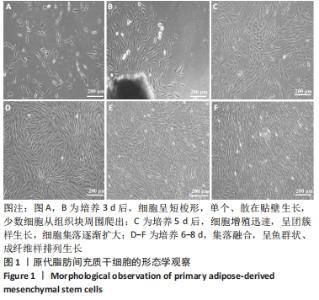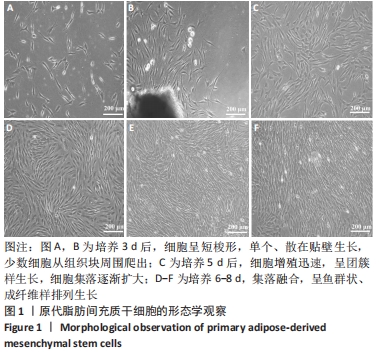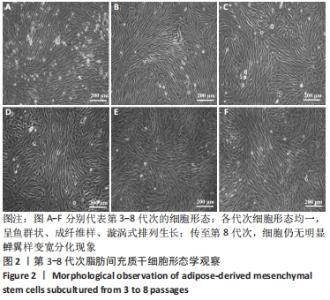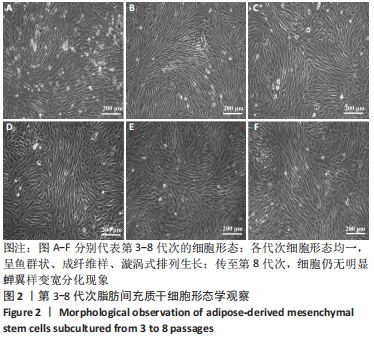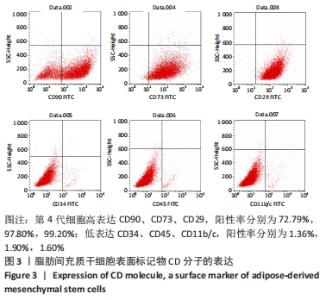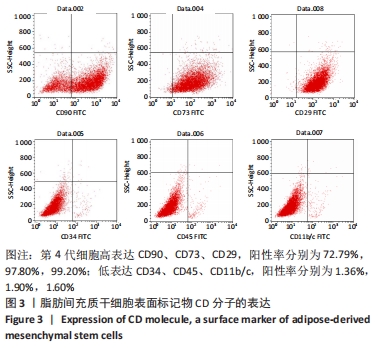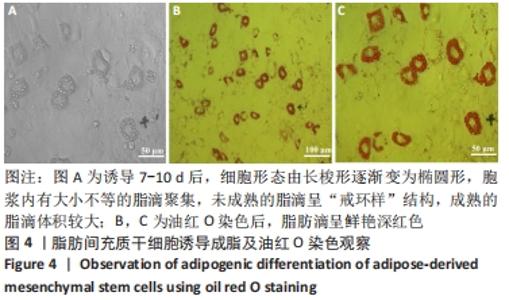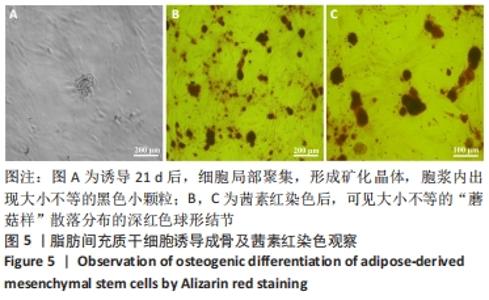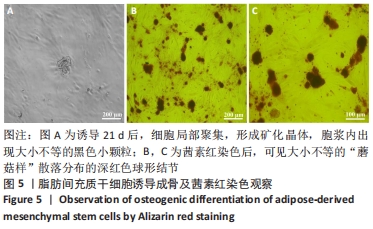[1] 张爽,刘石,汪宇峰,等.间充质干细胞修复骨关节炎软骨损伤的临床应用意义[J].中国组织工程研究,2018,22(33):5379-5385.
[2] 张金霞,刘伟江,苏菲娅,等.幼龄1型糖尿病模型小鼠脂肪来源间充质干细胞的鉴定及其成脂分化能力[J].中国药理学与毒理学杂志, 2021,35(5):345-352.
[3] 崔雅琦,白玉冰,许怡晨,等.脂肪来源的间充质干细胞及外囊泡促成骨分化的研究进展[J].上海交通大学学报(医学版),2020,40(12): 1672-1676.
[4] ALICKA M, MAJOR P, WYSOCKI M, et al. Adipose-Derived Mesenchymal Stem Cells Isolated from Patients with Type 2 Diabetes Show Reduced “Stemness” through an Altered Secretome Profile, Impaired Anti-Oxidative Protection, and Mitochondrial Dynamics Deterioration. J Clin Med. 2019;8(6):765.
[5] TAHA MF, HEDAYATI V. Isolation, identification and multipotential differentiation of mouse adipose tissue-derived stem cells. Tissue Cell. 2010;42(4):211-216.
[6] 韩雪雅,张海燕.肥胖相关脂肪组织微环境与脂肪干细胞特征的研究进展[J].中国细胞生物学学报,2020,42(11):2029-2037.
[7] 刘琴,王丽平,陈芳,等.悬浮组织块法分离培养SD大鼠脂肪干细胞的实验研究[J].中国免疫学杂志,2017,33(8):1197-1200.
[8] HURMUZ M, BOJIN F, IONAC M, et al. Plastic adherence method for isolation of stem cells derived from infrapatellar fat pad. Materiale Plastice. 2016;53(3):553-556.
[9] 岳永莉,张祥,张丽春.大鼠脂肪间充质干细胞的分离鉴定与生物学特性研究[J].中国细胞生物学学报,2016,38(11):1309-1316.
[10] 周虹,郭杏,李丹,等.大鼠脂肪间充质干细胞体外分离培养及CM-DiI标记后的传代示踪[J].安徽医科大学学报,2016,51(11): 1590-1595.
[11] GNANASEGARAN N, GOVINDASAMY V, MUSA S, et al. Different isolation methods alter the gene expression profiling of adipose derived stem cells. Int J Med Sci. 2014;11(4):391-403.
[12] MA H, YOUNG M, YUCUI Z. Stem cell markers research literatures. Stem Cell. 2016;7(1):101-115.
[13] SCHIPPER HS, PRAKKEN B, KALKHOVEN E, et al. Adipose tissue-resident immune cells: key players in immunometabolism. Trends Endocrinol Metab. 2012;23(8):407-415.
[14] LIN D, CHUN TH, KANG L. Adipose extracellular matrix remodelling in obesity and insulin resistance. Biochem Pharmacol. 2016;119:8-16.
[15] O’SULLIVAN J, LYSAGHT J, DONOHOE CL, et al. Obesity and gastrointestinal cancer: the interrelationship of adipose and tumour microenvironments. Nat Rev Gastroenterol Hepatol. 2018;15(11): 699-714.
[16] 李明,漆宜华,于良,等.调控肥胖脂肪细胞稳态的潜在靶点研究进展[J].中华保健医学杂志,2020,22(6):669-672.
[17] 武永乐,尚宏伟,孙广,等.小鼠脂肪组织中免疫细胞分离方法的优化及亚群在肥胖小鼠中的作用[J].首都医科大学学报,2021,42(4): 559-567.
[18] ROMACHO T, ELSEN M, RÖHRBORN D, et al. Adipose tissue and its role in organ crosstalk. Acta Physiol (Oxf). 2014;210(4):733-753.
[19] PÉREZ LM, BERNAL A, SAN MARTÍN N, et al. Metabolic rescue of obese adipose-derived stem cells by Lin28/Let7 pathway. Diabetes. 2013;62(7): 2368-2379.
[20] SCHIPPER HS, RAKHSHANDEHROO M, VAN DE GRAAF SF, et al. Natural killer T cells in adipose tissue prevent insulin resistance. J Clin Invest. 2012;122(9):3343-3354.
[21] CAN A, KARAHUSEYINOGLU S. Concise review: human umbilical cord stroma with regard to the source of fetus-derived stem cells. Stem Cells. 2007;25(11):2886-2895.
[22] MUSHAHARY D, SPITTLER A, KASPER C, et al. Isolation, cultivation, and characterization of human mesenchymal stem cells. Cytometry A. 2018; 93(1):19-31.
[23] 蒋茂莹,张艳,刘友学.大鼠前脂肪细胞消化酶原代培养方法改良的探讨[J].重庆医科大学学报,2009,34(6):743-746.
[24] 罗盛康,席菁乐.成人前脂肪细胞的原代培养[J].第一军医大学学报,2005,25(3):270-273.
[25] 侯晓琳,郁卫东,崔梅花,等.小鼠脂肪间充质干细胞的分离培养及肠道归巢[J].中国组织工程研究,2015,19(6):854-860.
[26] 王斯琪,卢海源,程腊梅. 3种不同组织来源的间充质干细胞促内皮祖细胞血管形成作用的比较[J].中南大学学报(医学版),2018, 43(2):184-191.
[27] 范友芬,潘艳艳,乐欣,等.绿色荧光蛋白转基因大鼠脂肪间充质干细胞的培养及分化潜能鉴定[J].现代实用医学,2018,30(2):150-152.
[28] STREM BM, HICOK KC, ZHU M, et al. Multipotential differentiation of adipose tissue-derived stem cells. Keio J Med. 2005;54(3):132-141.
[29] 赵学勇,张岩,于湄,等.悬浮法与贴壁法提取脂肪组织分泌促成脂因子比较[J].四川大学学报(医学版),2015,46(5):773-776.
[30] NADRI S, SOLEIMANI M, HOSSENI RH, et al. An efficient method for isolation of murine bone marrow mesenchymal stem cells. Int J Dev Biol. 2007;51(8):723-729.
|
